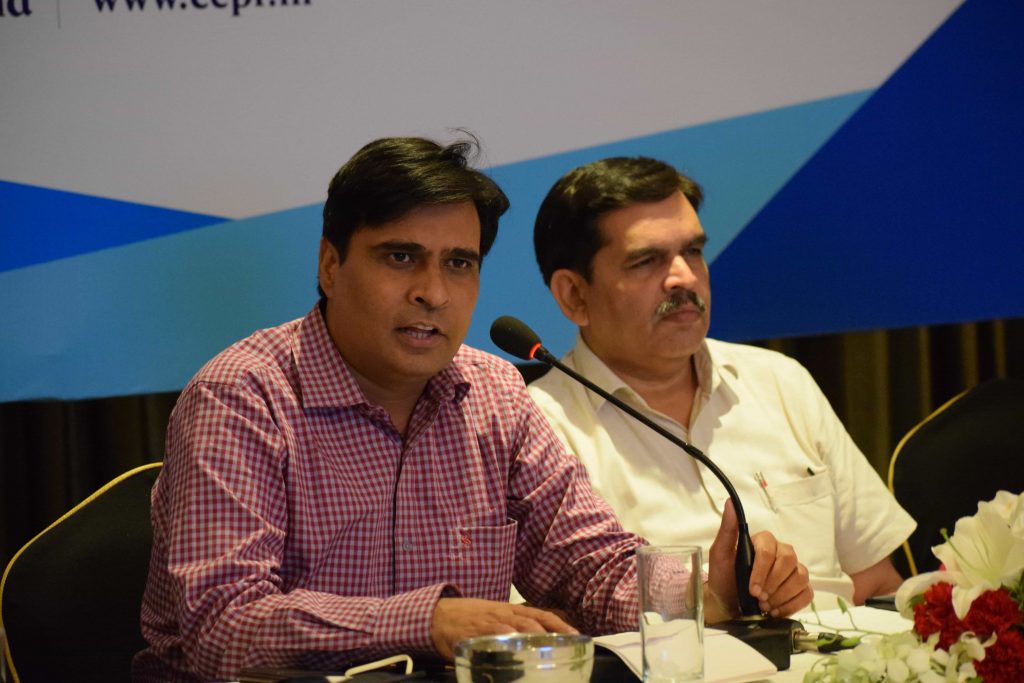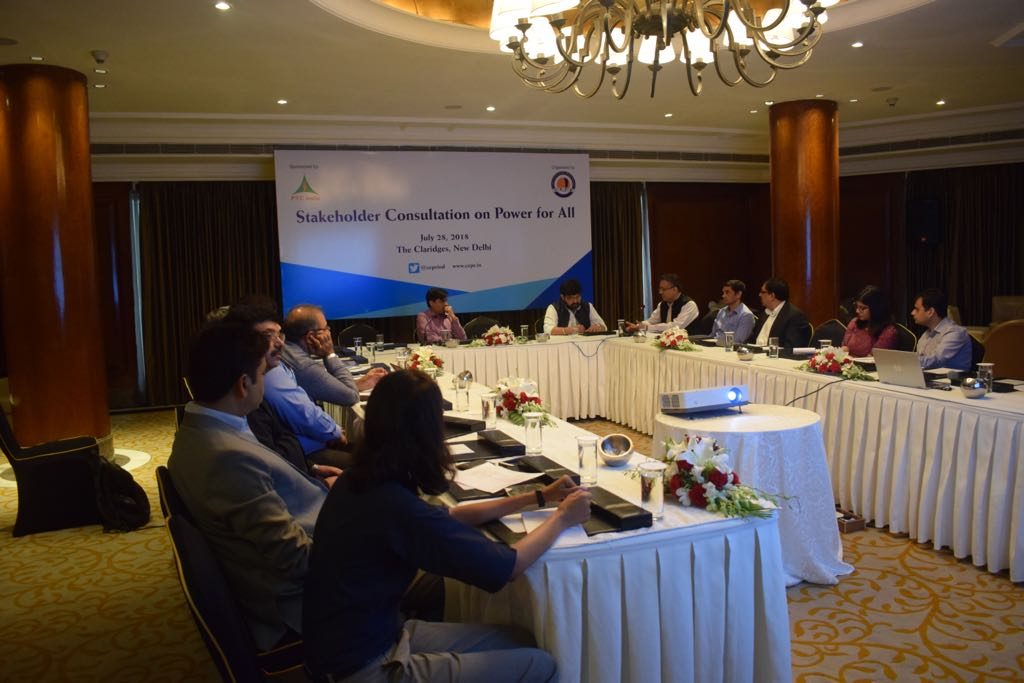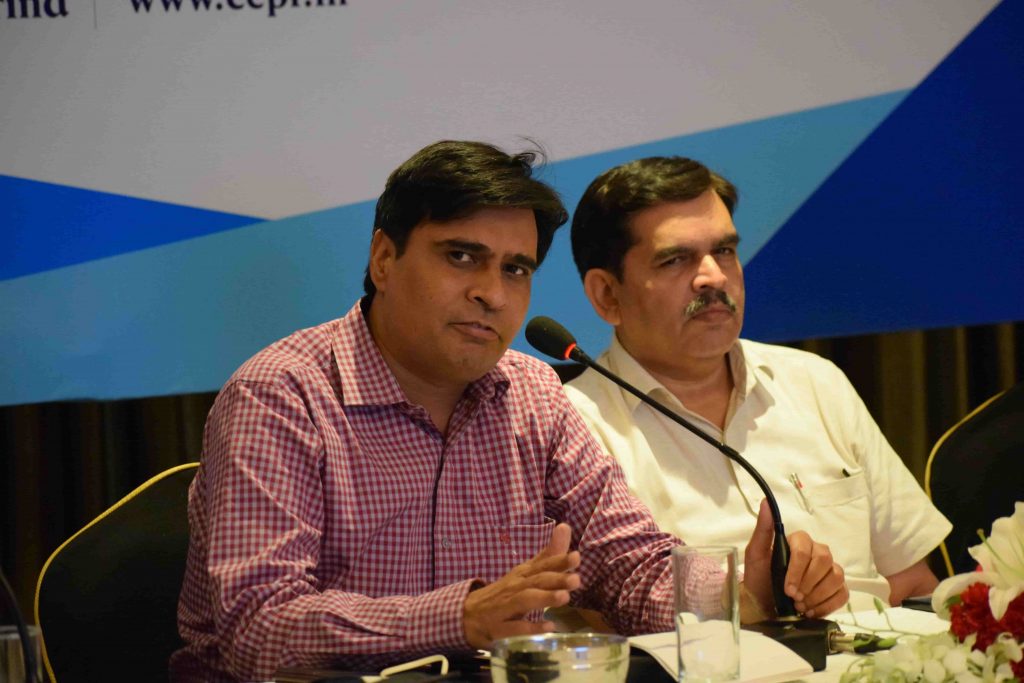CONSULTATION MEETING FOR POWER FOR ALL
July 28, 2018
Introduction:

Since 2008, India is one of the biggest consumer of energy in Asia, and is the third biggest in terms of its primary energy consumption globally, having a 5.5% global share in 2016, preceded only by China and USA. With respect to this rising demand,BP Energy Outlook said, We project that India and its energy consumption grows the fastest among all major economies by 2035. As a result, the country remains import dependent, despite increase in production.

In the 2014, with the commitment of providing the 24X7 electricity access to all Indians, PM Narendra Modi made his intentions clear. He set the ball rolling with massive plan to open up stranded coal mines, and agenda of taking coal production to 100 Billion Tonne was moved and ensured most of the generation units have enough coal linkage as well as supplies. With coal based generation firm power & mdash 197 GW crossing the peak demand load of 170 GW, India is surplus in supplies, but yet faces average 6 hours of load shedding. There are gaps, which are required to be fulfilled, before ensuring the 24X7 supplies.

ThePower for All schemes that was launched by the central government, in collaboration with the various state governments, is directed towards ensuring power availability for everyone, whether it be households, or businesses, or even agricultural farms. Now that a major portion ofDeen Dayal Upadhyaya Gram Jyoti Yojna is complete with electrification of all villages. This is been followed by another ambitious scheme of electrifying nearly three crore households,Pradhan MantriSahaj Bijli Har Ghar Yojana, or popularly known asSaubhagya. In the same direction it has launched a joint initiative with 36 states and union territories in India, with the commitment of providing 24X7 electricity, with both access and supplies. The decentralisation of the energy generation is another step in the same direction. There is a challengingPM Kissan Kisan Urja Suraksha evam Utthaan Mahabhiyan or KUSUM mission, of helping the farmers set up solar pumps.However, it still faces many challenges, from grid management to generation and storage of renewable energy that requires to be addressed.

Current energy landscape:
According to the recent BP Energy Outlook, India’s energy consumption is set to grow at a rate of 4.2% every year till 2035, faster than that of all major economies in the world. This would entail India’s gas demand to increase by 162%, followed by that of oil with 121%, and coal by 105%. Expected rise in the demand of renewable
energy is 712%, nuclear is 317%, and hydro is 97%. Substantial part of India’s energy demands is currently met by import- 80% of its oil, 50 per cent of its gas, and 23% of its coal demand. The basic strategy presently is to encourage the alteration of the energy basket.Increase the consumption of electricity, and replace the depleting fossil fuels. The major focus is on making the renewable sources of energy more viable. There is a continued focus on decarbonising the fuel mix due to growing climate concerns. In spite of the increased focus on renewable energy, fossil fuels, including oil, gas and,fuel, will still dominate the fuel mix. Thanks to advancement of technology,renewable is going to compete against other energy sources in grid parity leading to consumption of cleaner energy.
Power demand projections:
In shorter term, India has set an ambitious target of generating 175 GW of power from renewable energy that includes 100 GW from solar (utility and roof top), 60GW from wind, 10 GW from biomass, and 5 GW from small hydroelectric projects by 2022. Thanks to institutional support, the solar sector has grown manifold during last two and a half years with total installed capacity expected to leap from 3 GW in 2015 to 22 GW in 2017.
The electricity generation target of conventional sources for the year 2018-19, has been fixed to grow by 4.8%. Currently, the country total installed power capacity stands at 343.90 GW with thermal power contributing 222.69 MW, and renewable contributing 69.02 GW.
There is a consensus, in the next decade the energy basket will get disruption. With consumption of electricity may increase. This include with enhanced supplies in newer areas, the jump in the new commercial activities, more modernization of factories, replacement of fossil fuels –diesel and petrol with electric mobility, electricity replacing fuels of heating purpose et al. Along with this, India is looking at ways to reduce the dependence on oil many of them will shift to electricity.
Future Projections:
The solution to this increasing demand for power and energy is the judicious utilization of the abundant renewable energy resources present, such as biomass,wind, solar, ocean tidal energy, along with the utilisation of available technological advancements.
Grid connectivity:
The immediate surge in the generation of renewable energy, as well as the extrapolated future development in view of the consumption, production and supply of power, has raised severe questions over the availability of the infrastructure for energy transmission. The development of theGreen Energy Corridor, might help in this direction. The wastage of renewable energy on the grid also needs reduction. A focus on deploying distributed energy technologies like rooftop solar, can help in increasing the amount of solar energy in use where new transmission lines are still not available or are too expensive. There is a strong need of strengthening the transmission and distribution of electricity.
Blockchain and IoT:
With the use of smart grids, Big data analytics has developed a way in which unutilised power can be returned to the grid. It also allows for decentralised networks of power generation and transmission. A blockchain-enabled, decentralised P2P micro power grid structure can bring a small community together to buy or sell solar power for a certain price, without directing power to a central grid. The use of these technologies can greatly simplify the distribution of power in all areas, and make thePower for All scheme truly reach every one of its citizens.
Untapped areas:
Narmada canal solar power project should be replicated across the country. It will not only generate large amount of energy, but also help in saving the available land for agricultural use. Similarly, the distributed generation of power especially the solar powered water pumps in the farms. These can help farmer in getting access to electricity –at the time, when he requires—and also earn some additional money by selling power the local grid.
Floating solar:
Countries like Japan are exploring floating solar projects. Replicating these projects here will not only add a new dimension to solar power but also maximize the resource utilisation without using the limited land resources which might be needed in future to feed growing population.
Rooftop solar:
Promotion of rooftop solar and off-grid solar can offer rich dividend in minimizing pressure on grid. They can not only be implemented in urban buildings but also in villages where electricity supply is still a dream.
Battery storage:
Battery storage can not only provide power back up, but also they can be used to cover peak load, network balancing and grid stabilization. With the development of technology, the grid scale batteries are now big enough to give power backup to cities, and high voltage grids. Tidal power/Wave power:Production of tidal and wave power can not only help reduce the import energy bills, but can also be used to decarbonise the energy mix.The coastlines can also be used to generate wind power.